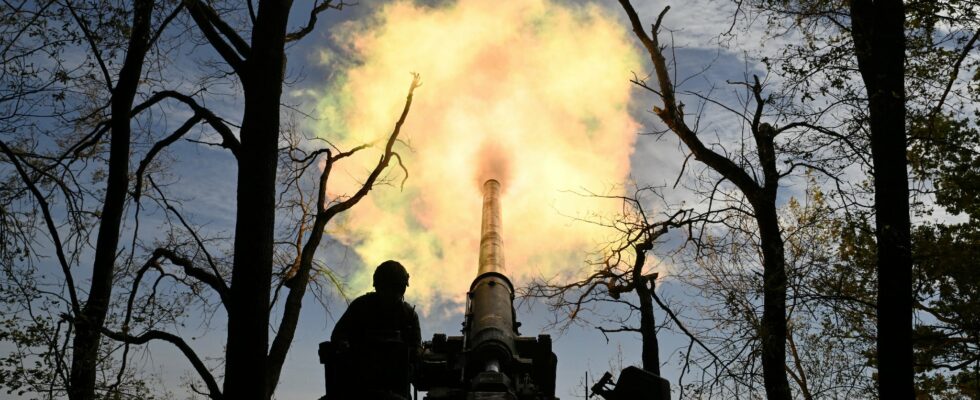For two and a half years, the city had held out under a deluge of fire and repeated assaults by the Russians. On October 2, Vouhledar, a Ukrainian stronghold in southern Donetsk oblast, finally fell. After final fighting, the 72nd Ukrainian mechanized brigade, responsible for defending the area, withdrew about seven kilometers further north to avoid encirclement. Although difficult, this decision had become inevitable. The day before, images of Russian soldiers waving their flag on the roof of the city council had started circulating on social media – marking the epilogue of one of the longest and bloodiest battles of this war.
At a time when the Russian army continues tirelessly to nibble away at Ukrainian territories in the east, this withdrawal above all illustrates the growing difficulties encountered in the Donbass by kyiv’s forces. “The trend is currently not good for the Ukrainians,” confirms General Nicolas Richoux. “They have appeared in a weak position for several months and are unable to regain the initiative.” The fall of Vouhledar will not help them. Beyond its symbolic character, this fortress town had become one of the hard points of Ukrainian defense in this sector located at the junction between the eastern fronts of Donbass and the southern fronts of Zaporizhia.
More delicate defense
Moscow had lost its teeth more than once. In February 2023, an offensive launched by the 155th Russian marine brigade ended in a resounding fiasco, with the loss of more than 1,000 men in two days, and around a hundred armored vehicles. Thanks to its elevated position, the city gave a natural defensive advantage to kyiv’s forces, offering a clear view of the kilometers of surrounding plain to Ukrainian artillery, and a decisive asset in countering the waves of infantry launched continuously by Moscow.
“It was one of the last fortified towns in the hands of the Ukrainians in this area,” notes Thibault Fouillet, scientific director of the Institute of Strategy and Defense Studies (IESD) at the University of Lyon III. taken de facto calls into question part of the Ukrainian defensive system in the southern sector.” Bad news for kyiv, whose difficulties are not limited to this single sector of the front.
Further north, Russian forces claimed the capture of the town of Zoryane on October 8, and are now only eight kilometers from Pokrovsk, a leading logistics hub. “The capture of this city would be very problematic for the Ukrainians,” notes General Richoux. “Its railway and road network constitute crucial axes for supplying the soldiers deployed in the sector.”
The T-0504 highway, which connects Pokrovsk to Chassiv Iar, via Kostiantynivka, allows men, equipment and ammunition to be transported as close as possible to the battlefield. Cutting this vital artery would further weaken the Ukrainian defenses in this sector of the front which, with its multiple ponds and small rivers, does not lend itself well to going off the track.
After the capture of Avdiivka last February, Russian forces began their slow advance towards the town, gradually taking locality after locality in a vast area around forty kilometers long and around twenty wide. Although firmly established, Ukrainian defense could become increasingly delicate in the long term on the Eastern front. “Even if the scenario of a collapse remains very unlikely, the Russians could end up reaching a form of soft underbelly as they progress, notes General Richoux. It is to be feared that the second and third lines of defense will be less thick than the first which had been fortified for several years.”
Offensive effort at Kursk
Despite the advances made by kyiv in the Kursk region, after the start of the offensive launched on August 6, Russian military pressure in the Donbass has not decreased in intensity. Far from Ukrainian hopes of seeing Moscow clear this front to protect its borders, the Russian general staff has only taken a tiny part. And on the contrary, it has accelerated its gains in recent months. “The Ukrainian calculation seems to have been to direct its efforts more in the Kursk region, even if it means taking resources from the defense of Donbass,” points out Camille Grand, former deputy secretary general of NATO, now a researcher at the European Council on Foreign Relations (ECFR). This probably helped facilitate Russia’s limited conquests in this area.
The coming months could prove decisive for the future of Donbass. “Russia has advanced by about one to two kilometers over the past week, noted Janek Kesselmann, deputy commander of Estonian intelligence, on October 4. If the intensity of the current attacks continues, the Ukrainian armed forces will probably be forced to withdraw from Pokrovsk by the end of the year and take up positions slightly deeper inside their territory.”
The fact remains that Moscow continues to pay a high price for its advances. According to a British intelligence note, the average daily casualty rate reached a new record in September, with 1,271 soldiers killed or wounded per day, compared to a previous peak of 1,262 last May. “Giving ground allows the Ukrainians to at least preserve their forces, while exhausting the Russians,” underlines Tomas Ries, professor at the Higher School of National Defense in Stockholm. “Because each of their offensives is very costly in terms of men.” Will the inflation in the number of victims push Moscow back? According to Western sources, their number has exceeded the mark of 600,000 killed and wounded since the start of the conflict.
.
